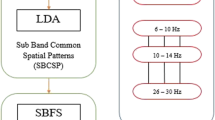Abstract
The discrimination of movement imagery electroencephalography (EEG) is an essential issue in brain-computer interfaces (BCIs). Classifying EEG signals is an important step in the discrimination process. From the physiological standpoint, EEG signal varies with the time elapse, mood, tiredness of the subject, etc. An excellent classifier should be adaptive to tackle the dynamic variations of EEG. In this paper, an incremental support vector machine (ISVM) is adopted to classifying the EEG. The ISVM can consecutively delete some history samples and replenish some new samples obtained lately. And so the classifier model of the ISVM is updated periodically to adapt to the variations of EEG. At the same time, the ISVM can use a small training set to train the classifier, which is better in training speed and memory consuming than the standard SVM.
To the data set 1 on left hand and foot imagery of BCI Competition IV 2008, the empirical mode decomposition (EMD) is employed to decompose the EEG signal into a series of intrinsic mode functions (IMFs), and then AR model parameters and instantaneous energy (IE) can be gained from some important IMFs, which form the initial features. The extracted features are fed into the ISVM classifier. Compared with the standard SVM, elementary results show that the ISVM can obtain better classification performance. The ISVM provides a good way to solve the adaptability of the online BCI system. Even so, the effectiveness of the ISVM should be verified furthermore with more data and subjects.
Access this chapter
Tax calculation will be finalised at checkout
Purchases are for personal use only
Preview
Unable to display preview. Download preview PDF.
Similar content being viewed by others
References
Wolpaw, J.R., Birbaumer, N., McFarland, D.J., Pfurtscheller, G., Vaughan, M.T.: Brian-computer interfaces for communication and control. J. Clinical Neurophysiology 113, 767–791 (2002)
Li, Y.Q., Guan, C.: A Semi-supervised SVM Learning Algorithm for Joint Feature Extraction and Classification in Brain Computer Interfaces. In: 28th IEEE EMBS Annual International Conference, pp. 2570–2573. IEEE Press, New York City (2006)
Vidaurre, C., Schlöogl, A., Cabeza, R., Scherer, R., Pfurtscheller, G.: A Fully On-Line Adaptive BCI. IEEE Transactions on Biomedical Engineering 53(6) (2006)
Wang, L., Xu, G.Z., Wang, J., Yang, S., Yan, W.L.: Application of Hilbert-Huang Transform for the Study of Motor Imagery Tasks. In: 30th Annual International IEEE EMBS Conference, pp. 3848–3851 (2008)
Windhorst, U., Johansson, H.: Modern Tecniques in Neuroscience Research. Springer, New York (1999)
Penghai, L., Baikun, W.: A Study on EEG Alpha Wave-based Brain-Computer Interface Remote Control System. In: 2007 IEEE International Conference on Mechatronics and Automation, Harbin, China (2007)
Wu, W., Gao, X.R., Hong, B., Gao, S.K.: Classifying Single-Trial EEG During Motor Imagery by Iterative Spatio-Spectral Patterns Learning. IEEE Transactions on Biomedical Engineering 55(6) (2008)
Molina, G.G.: BCI Adaptation using Incremental SVM Learning. In: 3rd International IEEE EMBS Conference on Neural Engineering, Hawaii, USA, pp. 337–341 (2007)
Niedermeyer, E., Silva, Lopes da Silva, F.H.: Electroence phalo graphy: Basic Principles, Clinical Applications and Related Fields, 4th edn. Williams and Wilkins (1999)
Vapnik, V.: The Nature of Statistical Learning Theory. Springer, New York (1995)
Oostenveld, R., Praamstra, P.: The five percent electrode system for high-resolution EEG and ERP measurements. J. Clinical Neurophysiology 112, 713–719 (2001)
Author information
Authors and Affiliations
Editor information
Editors and Affiliations
Rights and permissions
Copyright information
© 2010 Springer-Verlag Berlin Heidelberg
About this paper
Cite this paper
Zheng, X., Yang, B., Li, X., Zan, P., Dong, Z. (2010). Classifying EEG Using Incremental Support Vector Machine in BCIs. In: Li, K., Jia, L., Sun, X., Fei, M., Irwin, G.W. (eds) Life System Modeling and Intelligent Computing. ICSEE LSMS 2010 2010. Lecture Notes in Computer Science(), vol 6330. Springer, Berlin, Heidelberg. https://doi.org/10.1007/978-3-642-15615-1_71
Download citation
DOI: https://doi.org/10.1007/978-3-642-15615-1_71
Publisher Name: Springer, Berlin, Heidelberg
Print ISBN: 978-3-642-15614-4
Online ISBN: 978-3-642-15615-1
eBook Packages: Computer ScienceComputer Science (R0)





